Tag: Barrel Oak Winery
Picking the clones: you work with what you have
One of the toughest calls we've had to make concerns the types of grapes we’re going to grow. I know what I like – well, to be honest, I like a lot of things when it comes to wine. Almost everything actually. But I especially love Bordeaux-style blends, wines made with some combination of Cabernet Sauvignon, Merlot, Cab Franc, Petit Verdot and maybe some Malbec, as well as blends from the Southern Rhone (Grenache, Syrah and Mourvedre, and perhaps a bit of Cinsault). And I haven't even started on the single-grape varietals that I love, which are too numerous to mention (but I’ll give it a shot anyhow): each of the above-named Bordeaux and Rhone grapes on their own, plus Pinot Noir, Nebbiolo (especially Barolo), Sangiovese, Chardonnay, Viognier, Sauvignon Blanc, and – okay, okay, it’s time to stop.
You see the problem. If the world were a perfect place, I’d just pick the grapes I love the most, and we’d have some wonderful blends and some lovely single-grape varietals.
But of course, the world isn’t perfect, and you have to work with what you have. So, our first limitation is the fact that we have a small plot of land that forces us to narrow our selections down to three or four grapes. That’s fine, though. This is a hobby, not our vocation. (Ah, but if only. As I said, though, the world is not a perfect place.)
More important is the terroir, the mix of soil, climate, elevation, aspect and everything else that determines how a Merlot grown here, on my property, will be different from a Merlot grown on the right bank of the
We won't have 14 rows of Cab Franc, but we will have Cab Franc!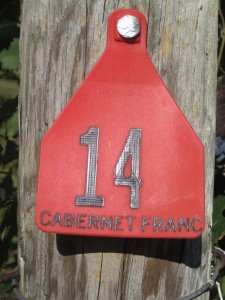
Gironde River or in Napa or even in the King Family Vineyard a few miles away in Crozet. And it’s not just a question of why our Merlot will be different from Merlots grown elsewhere. It’s also a question of whether Merlot can be grown successfully on our property at all. We're not so sure about Merlot.
The fact is, Virginia isn’t the easiest place in the world to grow grapes. Unlike the wine valleys in California or eastern Washington state, we are dealing with humid summer days and lots of rain, and we can’t count on the kinds of long sunny days that you get in, say, Sonoma County. Our property is about 760 feet above sea level, below the thermocline that provide optimal temperatures for grapes and protection from late Spring frosts or early freezes.
So, where does that leave us? I’ve sampled a lot of different Virginia wines in a lot of different Continue Reading–>
Bringing in the Grapes – Part I
It’s getting on toward the end of September, and the wine grape harvest is in full swing. Most vineyards have harvested most of their white grapes, which ripen early, and are watching their reds very closely, with one eye on the grapes and the other on the weather. Agriculture is an unpredictable
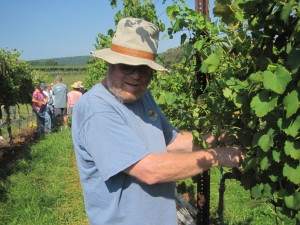
- An unguarded moment picking grapes at Blenheim Vineyards — mostly I had my eyes on my work while using pruning shears to snip clusters of grapes.
business, and there are a lot of tough decisions to be made, especially in a growing season that has featured too much rain at the wrong times. (Thank you, Irene.) Sometimes it comes down to a compromise – do I pick the grapes now, when they’re not quite perfect, or wait and hope that weather doesn’t get in the way and cost me the entire harvest? It’s an especially troublesome set of decisions now, in the midst of the 2011 harvest, for several reasons.
For one, the wet conditions are a breeding ground for disease, particularly Downy Mildew and Botrytis, and spraying isn’t always possible in these last weeks. That’s a problem for this year, if you’re trying to avoid issues such as sour rot, and it’s a problem for next year as well. Mizuho Nita, a grape pathologist at Virginia Tech, notes that while the berries (grapes) should be resistant to Downy Mildew, vineyard managers need to be concerned about the effect of disease on the canopy.
“Vines need healthy leaf areas for accumulation of carbohydrate into the main trunk in order to survive the winter,” he said in a recent blog post.
In addition, the grapes swell with water after a rain, which dilutes the wine that would be made from them. Brix levels (a measure of the sugar and potential alcohol) drop after a big rain, and the skins may crack, which is a cause of sour rot. Moreover, the skins, which provide color and tannin to reds, may be too thin to do their job well.
“Mother Nature certainly isn’t doing us any favors with all of this rain and the never-ending dreary days,” says Sharon Roeder, winemaker at Barrel Oak Winery (BOW, for the dog-lovers among you – and who isn’t a dog lover!).
Despite the weather, Sharon says she’s still pleased with what she’s seeing from the harvest – at BOW, they’ve already brought in Seyval Blanc, Chardonnay, and Vidal Blanc – but the year will be challenging for winemakers, she says.
“The 2011 vintage won’t be a piece of cake, and the winemakers are definitely going to have to pay attention,” she adds. “But those who put their experience to use and take advantage of the resources available to us certainly have an opportunity to craft some excellent wines this year.”
At DuCard Vineyards, where I’ve been learning about vineyard management through a series of hands-on classes, owner and winemaker Scott Elliff has a similar perspective. He’s picked the Viognier, and is grateful to have those grapes in the barn. Some vineyards, he noted, were delayed by rain, and by the time crews arrived to pick, the crop was lost.
Reds are a different story. With Cab Franc and Petit Verdot, Scott is holding out. “We are seeking to maximize ripeness and maturity and not ‘just’ get to acceptable Brix levels,” he said.
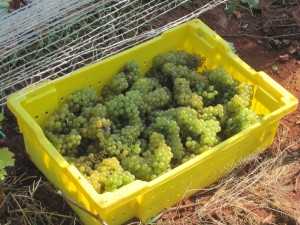
We were pretty ruthless in deciding which grapes to keep, but it was worth it. They could not be more beautiful. Can't wait to go back to Blenheim next year and taste the wine.
However, “it’s a crapshoot,” he added Friday, especially after looking at the forecast that morning. He wants to bring the grapes in when they’re as close to perfect as possible – and that means more than the right balance of sugar and acidity.
Julien Durantie, DuCard’s vineyard manager, said that even though the numbers were decent, the Cab Franc grapes still have green seeds. The green color means the seeds aren’t fully mature, which imparts a bitterness to the wine.
And of course, there’s so much more to the decision about when to harvest. You can measure the Brix with a refractometer, measure the pH and look at the seeds. But Brix is just a measure of sugar and potential alcohol, and you can add sugar to the fermenting wine to correct for low Brix. A good winemaker also brings his or her experience to bear on the decision about when to harvest, and of course, they never really have full control.
It’s harvest at its best, Julien says – “A wonderful nightmare.”
Getting Ready for the Spring Planting
We’ve learned a lot about viticulture (so much so that if we were in the army, the body of knowledge we’ve accumulated would fall under the heading of “knowing just enough to get us killed”), and so we’re feeling like we want to plant a larger vineyard this Spring. “Larger” is a relative term, of course; given that we’re starting with a vineyard of seven vines, it would be hard to go smaller. We’re thinking of something between 100 and 200 vines.
Most people in the business, even most backyard vintners, would regard that as a small undertaking, but it’s large for us, especially since we won’t be living close to this vineyard for at least the next few years. Everything we plant has to be maintained, and that includes spraying very soon (within 24 hours) after any rainfall that drops more than three-quarters of an inch of water onto the vines. So, while the number of vines we’re considering is very small by most standards, it’s sizeable by the criteria most relevant to us.
However, it makes the question of what grapes to plant – and how many different types of grapes to plant – much more complicated.
In a small vineyard like ours, it’s probably best to plant relatively few types of grapes, since it’s easier to process 50 gallons of one type of wine that 25 gallons each of two varieties. Well, we’re going for fun, not efficiency, so we’re thinking of four or five, all in the Vitis vinifera family of European-style grapes. There are others, such as Norton, a Virginia original, that are much easier to grow (less spraying, less worry all around), and many Virginia wineries say that Norton is their most popular grape. But again, we intend for this to be a labor of love, so while we’re not going to disregard entirely issues of suitability, we’ve decided to grow varietals that we love.
First off, we want a white, and Viognier has been named Virginia’s signature grape by the Virginia Wine Board. We wouldn’t agree that Viognier is the best grape, period, for Virginia, but among whites, we do think a Virginia Viognier is something quite special. Chardonnay and other whites do well here, but I think Viognier grown in Virginia has the potential to be world class. So, Viognier makes the cut – three (or maybe four) to go.
Next, we’d like to have some kind of desert wine, and after drinking a bottle of Petit Manseng from Veritas Vineyards over the weekend, we decided to add that one as well to the shopping list. Two down, now on to the reds.
We like Bordeaux-style blends, so we want to choose from among the great grapes of Bordeaux: Cabernet Sauvignon, Merlot, Cab Franc and Petit Verdot. (I’m not counting Malbec, which I doubt will do well on our property.) We’ve had all four from Virginia wineries, so we know they’re at least realistic options.
Almost everyone agrees that Cab Franc does well in Virginia, and we’ve had good Cab Francs from many wineries. In addition, the dozen Cab Franc vines that we planted in our two separate “vineyards” seem to be doing quite well, despite the late planting. So Cab Franc seems like an easy choice. But the results we’ve observed from Cab Sauv and Merlot are a bit spottier.
We’ve had very good Merlots from King Family Vineyards, among other wineries, and we tasted a lovely Merlot at Barboursville Vineyards Saturday, full of fruit, and very drinkable. I’ve also had a few Cabs from Virginia wineries that I’ve enjoyed, including one at Barboursville last weekend, but on the whole, I have to say that I haven’t loved Virginia Cabs as much as I would have liked. It would be nice to have one of the two for Bordeaux blends, and while my heart is always with Cab Sauv, my head tells me that Merlot is the better choice for us. This is a tough one.
That brings me to Petit Verdot. Two years ago, I had never tasted Petit Verdot as a varietal, and I can recall being surprised the first time it was offered in a tasting room. I remember enjoying it, but thinking of it as a bit of a novelty. I had grown up believing that Petit Verdot was a blending grape that was used in small amounts to correct acidity in Bordeaux blends.
A few weeks ago, when we decided to give Petit Verdot serious consideration for our vineyard, we visited a couple of wineries that bottled this grape as a varietal. Both were sold out, which we thought was a good indicator of what wine-drinkers think of Virginia Petit Verdot.
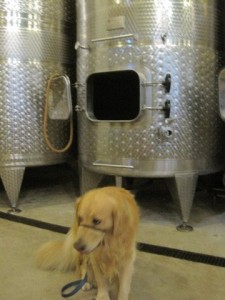
Phoenix, the Vineyard Dog, inspecting BOW's tank room. Here he is walking away from a tank after discovering that it was empty.
Our major concerns at this point were all practical. Petit Verdot is a late-ripening grape, at least as late as Cab Sauv, which we think might be hard to grow, and that concerned us. On the way home from Nelson County Thursday, we stopped at Barrel Oak Winery (BOW), which is not only dog friendly (Phoenix the Vineyard Dog was traveling with us), but we thought it featured a Petit Verdot (PV for the rest of this post).
Alas, BOW was also sold out of PV. However, we lucked out. Sharon Roeder, who owns BOW along with husband Brian, and serves as its winemaker, took us on a tour of the winery, and offered a barrel sample of the 2010 PV.
It’s not so easy to tell how a wine will develop as it continues to age in the barrel, and then ages some more in the bottle. But I was just blown away by this Petit Verdot. It’s a big, bold, exuberant wine that is just full of fruit. I would have loved to have poured a bottle and taken it home. However, this wine has a ways to go before it’s bottled sometime in the Spring of 2012. Before bottle aging starts, it will have spent 15 months in oak. Fortunately, BOWs 2009 PV will be released in a couple of months. I expect to be first in line.
So, that tasting eliminated by doubts about growing Petit Verdot. Maybe it’s more difficult than other grapes, but the results are surely worth it. And while I agree that Viognier is Virginia’s signature white grape, I’m wondering if Petit Verdot will join Cab Frank as the Commonwealth’s (by my reckoning) signature red.
So, we’re done to Viognier, Petit Manseng, Cab Frank, Petit Verdot, and maybe Merlot. Now the real challenges begin. How much of the total vineyard to plant next Spring? How many of each varietal? And which nursery to buy the vines from? Tough questions. Probably best to ponder them over a glass of wine. Maybe a Virginia Viognier.

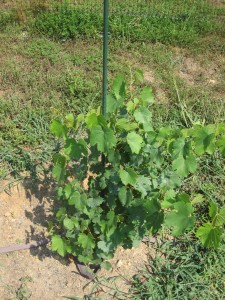


Recent Comments